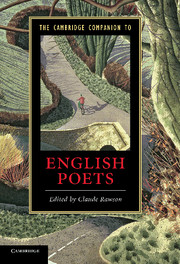Book contents
- Frontmatter
- Introduction
- 1 Geoffrey Chaucer
- 2 Thomas Wyatt
- 3 Edmund Spenser
- 4 William Shakespeare
- 5 John Donne
- 6 Ben Jonson
- 7 George Herbert
- 8 John Milton
- 9 Andrew Marvell
- 10 John Dryden
- 11 Jonathan Swift
- 12 Alexander Pope
- 13 William Blake
- 14 Robert Burns
- 15 William Wordsworth
- 16 Samuel Taylor Coleridge
- 17 George Gordon, Lord Byron
- 18 Percy Bysshe Shelley
- 19 John Keats
- 20 Alfred Lord Tennyson
- 21 Robert Browning
- 22 Emily Brontë
- 23 Christina Rossetti
- 24 Thomas Hardy
- 25 William Butler Yeats
- 26 D. H. Lawrence
- 27 T. S. Eliot
- 28 W. H. Auden
- 29 Philip Larkin
- Further Reading
- Index
26 - D. H. Lawrence
Published online by Cambridge University Press: 28 May 2011
- Frontmatter
- Introduction
- 1 Geoffrey Chaucer
- 2 Thomas Wyatt
- 3 Edmund Spenser
- 4 William Shakespeare
- 5 John Donne
- 6 Ben Jonson
- 7 George Herbert
- 8 John Milton
- 9 Andrew Marvell
- 10 John Dryden
- 11 Jonathan Swift
- 12 Alexander Pope
- 13 William Blake
- 14 Robert Burns
- 15 William Wordsworth
- 16 Samuel Taylor Coleridge
- 17 George Gordon, Lord Byron
- 18 Percy Bysshe Shelley
- 19 John Keats
- 20 Alfred Lord Tennyson
- 21 Robert Browning
- 22 Emily Brontë
- 23 Christina Rossetti
- 24 Thomas Hardy
- 25 William Butler Yeats
- 26 D. H. Lawrence
- 27 T. S. Eliot
- 28 W. H. Auden
- 29 Philip Larkin
- Further Reading
- Index
Summary
Primarily a novelist – the author of Sons and Lovers (1913), Women in Love (1920), and other well-known novels – D. H. Lawrence (1885–1930) was also a highly original poet, whose early lyrics not only found a wide audience but won the praise of such unlikely fellow-poets as Edward Thomas, Ezra Pound, and Conrad Aiken. ‘Mr. Lawrence’, declared Pound in a review of Love Poems and Others (1913), ‘almost alone among the younger poets, has realized that contemporary poetry must be as good as contemporary prose if it is to justify its publication.’ The ‘prose’ in question – perhaps Lawrence’s own – was praised for its vivid imagery and uncanny accuracy of observation: Pound’s friend Ford Madox Ford, then editor of the influential English Review, remarked that only an especially ‘observant’ writer would call a short story ‘Odour of Chrysanthemums’, for ‘The majority of people do not even know that chrysanthemums have an odour.’
Yet by the time of Lawrence’s untimely death from tuberculosis in 1930, the reaction had set in. In 1927, T. S. Eliot, who denounced Lawrence’s treatment of sexual love, declared that ‘Mr. Lawrence is … a natural and unsophisticated demoniac with a gospel … [his characters] seem to reascend the metamorphoses of evolution, passing backward beyond ape and fish to some hideous coition of protoplasm.’ And by 1935, the American critic R. P. Blackmur characterized Lawrence’s poetry as suffering from the ‘fallacy of expressive form’ – the fallacy that ‘if a thing is only intensely enough felt its mere expression in words will give it satisfactory form, the dogma … that once material becomes words it is its own best form’. This charge – an absence of adequate form to contain the poetry’s often overwrought, if not hysterical, content – has continued to dog Lawrence ever since.
- Type
- Chapter
- Information
- The Cambridge Companion to English Poets , pp. 475 - 490Publisher: Cambridge University PressPrint publication year: 2011

